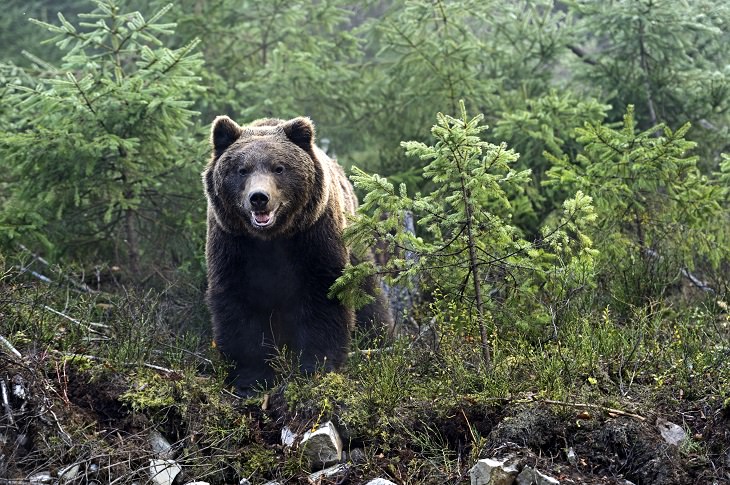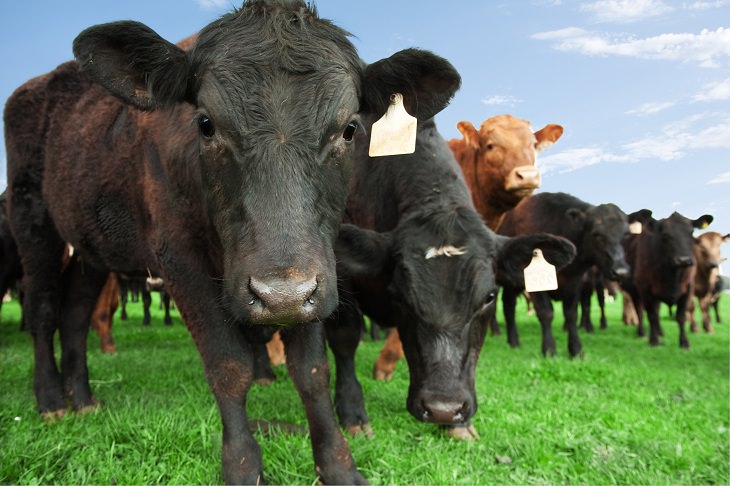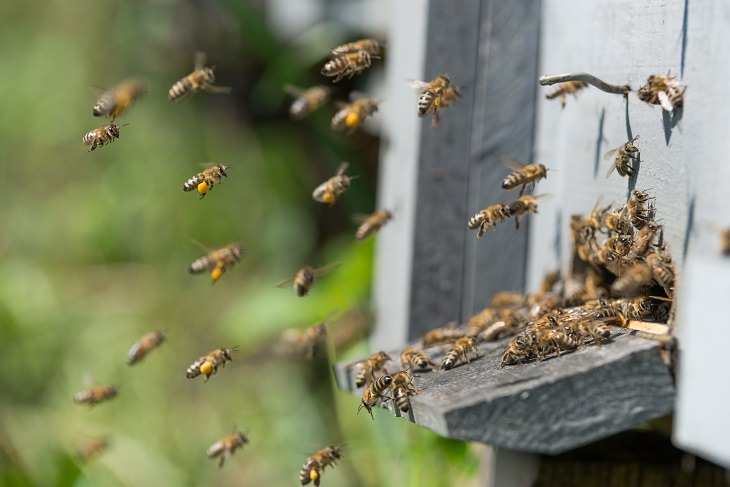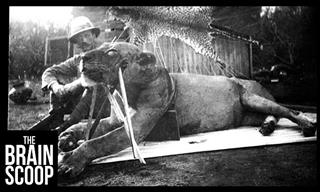

Jared A. Forrester, a surgeon from Stanford University, who led the investigation into fatalities caused by animals in the US from 2008-2015 says that, “Most deaths aren’t actually due to wild animals such as mountain lions, bears, wolves, or sharks. So, while it’s important that people recreating in the wilderness know what to do when they encounter a potentially dangerous animal, the risk of death is quite low.”
So, if wild animals with sharp claws and teeth aren’t the biggest risk to people in the US, then what is?
Well, if you exclude stinging winged insects for a second, the deadliest animals to humans in the US are those that we have living in and around our homes – and our homesteads. Farm animals – mainly cattle and horses – are actually the biggest killers, being responsible for 576 deaths (36% of all fatalities) in the period, claiming an average of 72 deaths per year.

Dogs were responsible for a little less than half that, coming in third overall with 272 deaths.
For such a beloved animal that makes up a valuable part of so many families, dogs’ inclusion on the list ought to be a wake-up call for everyone, especially for parents: children under the age of four are killed at a rate almost two times higher than the next most vulnerable group (people over the age of 65), and four times higher than other age groups.
While dogs can be deadly, they don’t claim as many lives overall as winged venomous insects of the order Hymenoptera – comprising of bees, hornets, and wasps – the second biggest killer in this study. Stings from these flying insects killed 478 people overall during the study period – 6- per year on average.
This might be shocking, but what’s more shocking is this: since the last time the researchers analyzed this kind of data – covering the period 1999-2007 – the cost of some epinephrine autoinjectors have skyrocketed by more than 400%.
This is a huge issue, since these kinds of treatments are what saves the lives of people who are suffering anaphylactic shock brought on by venomous insect stings. “With an estimated 220,000 annual visits to the emergency department and nearly 60 deaths per year due to stings from hornets, wasps, and bees, effective and affordable treatment for anaphylaxis from Hymenoptera is critical,” the researchers write in their paper.

Therefore, “public health practitioners, policymakers, and the public should encourage the industry to provide proven public health interventions, like the EpiPen, at a socially responsible price point that serves the best interest of the US population.”
Another thing that the research team is calling for is greater awareness of the risks animals at large can cause to people in the US. Although deaths due to animals haven’t risen since the researcher’s last study, they haven't declined either. This is not a good thing, as the team believes that most of these fatalities caused by animals should ultimately be preventable.
In the same period in which dogs killed 272 people, 49 people were killed by spiders, 48 lost their lives to snakes, sharks killed 13 people, and scorpions claimed the lives of just two.
Source: sciencealert
Images: depositphotos
 18:00
18:00
Hammerhead Sharks - Eevolution's Strangest Turn
Around 20 million years ago evolution introduced hammerhead sharks. Why did evolution make such a surprising turn and what makes these sharks so uniqe?
 4:54
4:54
Pigeons Have Played a Massive Role in World History
Pigeons are one of the most common birds in the world, but they're utterly underrated. In fact, they have played a huge role in world history. Find out more...
 3:08
3:08
This Rescue Video Will Have You at the Edge of Your Seat
Watch as this impressive wild leopard gets stuck in wire and eventually rescued by a professional team.

Forget Apples! It's an Egg a Day That Keeps the Doc Away...
According to new research, it could actually be an egg a day that keeps the doctor away.Find out more here!
 11:53
11:53
These Cases Were Cold... Until Science Cracked Them
Technology and science aren't always about the future. Take a look at these cold cases that were solved only thanks to the advances of science.
 5:04
5:04
Ever Wondered How Hormones Work? Well, Wonder No More...
Ever wondered how hormones work? Well, wonder no more as this informative TED-Ed video explains all!

Your Cat Isn't Weird, It's Just Trying to Say Something
Many cat behaviors have human equivalents, however we often have problems interpreting them. Thanks to this handy guide, you will not anymore!
 2:37
2:37
How Far Back in Time Could You Go and Still Understand English?
Languages are born, change, and die. English, we presume, is no exception. So how far back in time could you go and still understand anything...?

7 Ancient Buildings That Have Survived the Test of Time
Here is a look at some wonderful ancient structures that have survived the test of time.

When Animals Go Rogue: True Tales of Man-Eating Animals
Throughout history, many animals have turned into deadly man-eaters. Here’s a list of the most intense books on the subject.
 11:47
11:47
This Brilliant Talk Taught Me to Let Go of My Delusions
Isaac Lidksy has had quite an amazing life of success, which he puts down to a stunning realization that blindness gave him. Watch. You won't be disappointed.

12 Vintage Christmas Songs That Still Warm Hearts
These classic Christmas songs capture the spirit of the season.

From Food to Science - The WORST Misnomers You’ll Find!
Whoever named these objects must have seriously run out of imagination!

Hello, January: Inspiring Quotes to Greet the New Month
Let’s start the new year with these amusing and inspiring January quotes.

12 of the Most Inexplicably Weird Things Ever Discovered
In the world, a lot of discoveries often raise more questions than they answer. Here are 12 of the most inexplicably weird things and places ever found.

5 Unexplained UFO Encounters That Puzzled Experts
We may not believe in UFOs, but throughout history there have been some rather strange UFO-like encounters that defy logic.
 14:50
14:50
The Mandela Effect: When Everyone Misremembers History
The Mandela Effect is a strange phenomenon, where large amounts of people seem to remember things differently.

Rare Interesting Historical Photos That are Must-See
You won’t find these rare photos in your history books.
 5:33
5:33
White Rose: the Brave Student Resistance to Nazi Germany
White Rose was a secret student organization that opposed the Nazi rule, here is the story of this brave organization...
 12:37
12:37
These Naval Battles Changed the Course of History
History has been witness to some momentous naval battles. Here is a look at some of the greatest.

It’s a Shame We Stopped Using These 17 Old English Words
These 17 old words are definitely missing in our modern vocabularies and deserve to be brought back into day-to-day speech

Incredible History: Looking Through 21 Fascinating Photos
Enjoy this collection of historical pictures.

History: The Full Story of Napoleon's Epic Defeat
The full story of the battles Napoleon fought that eventually lead to his ultimate defeat.

If You Like Greek Mythology, Don’t Miss These Movies!
If you’re interested in Greek mythology, then make sure you check out these amazing films.

22 Words Uttered By Writers In Their Final Moments
The world's most famous writers had a way with words right up until the point of their deaths, as these 22 images are about to show you.

These Are the Most Famous Swords Ever Forged!
Check out 8 of the most legendary swords to have ever graced the field of battle!
 7:17
7:17
The Truth About June. Touching and Wonderful.
A beautiful story about a mother's love, which I warmly recommend.

7 Notable Han Dynasty Inventions That Changed the World
Here, we look at some of the great inventions from the Han dynasty of China that had a great impact on the world.

Historic Photos From Days of Christmas' Past...
Christmas is said to be a time of love, cheer, and human compassion. These photos may be decades-old, but the stories they tell are not much different than the stories of today.
 9:16
9:16
The Most Notorious Man-Eating Lions in History
Do you know the strange history of the man-eating lions of Tsavo?

Check Your Pockets Now! This Quarter Is Worth Thousands!
There's a quarter out there that is worth thousands of dollars. Here's what you need to look out for.

You’ll Love Learning New Things With These Awesome Charts
It's time for a brand new collection of fascinating charts and guides.

10 Difficult Words in English Everyone Should Know
English has many difficult words with meanings that are nearly impossible to guess, which makes them super tough to remember. Here are 10 such words

14 Senior Graduates Prove It’s Never Too Late To Learn
Here are 14 inspiring examples of people who pursued education and knowledge in their senior years.
 8:28
8:28
Was The First Famous War Photo in History Staged?
“The Valley of the Shadow of Death” is the first famous war photo in history, but journalists started questioning its genuineness. Was this famous photo staged?

13 People Who Proved that Age is Nothing But a Number
If you think that celebrating your golden jubilee means you're past your prime, then these 13 people have something to teach you...
 44:39
44:39
Full Documentary: The Fascinating History of the Dark Ages
Watch this fascinating documentary that sheds some great insight into how Rome fell, and what the Dark Ages actually consisted of.
 5:02
5:02
Watch a Thai Chiropractor Fixing a Spine With a Hammer!
Thailand is a country that's known for specializing in many different kinds of massages, but would you dare be massaged by a man wielding a hammer?
 8:21
8:21
Wow! I Had No Idea That Whales Could Show Gratitude!
One whale was so grateful for the man who saved his life, he showed his appreciation - by dancing!

Find Humor & Inspiration in These Douglas Adams Quotes
May you find inspiration and humor in these quotes by Douglas Adams.

10 Questions You Always Wanted the Answer To
Let's dive into ten questions you've always wanted to ask and uncover the intriguing science behind everyday phenomena.

5 Famous Shipwrecks and Their Unbelievable Stories
Some unreal stories about what lies deep below the seas.

Wishing You a GREAT 4th OF JULY! Celebrate America!
Be proud of being an American and share one of these meaningful 4th of July cards with everyone. HAVE A GREAT 4TH OF JULY!

115 Incredible Facts You Never Knew About Cats!
Cats are the most popular animal on the internet by far, so we made this extensive list of cat facts that will turn you into a feline expert!

Nostalgia: Gorgeous Photos of America in the 1950s
We hope you enjoy these beautiful captures of the 1950s in the USA.

30 Essential Medical Terms For Bodily Functions
The next time you hear a doctor utter something in Latin, pay close attention, as after reading this article, you may understand what it means.


